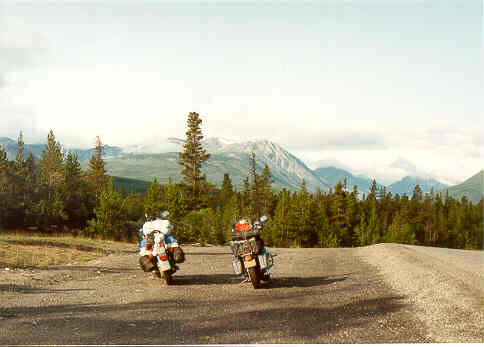Construction of this highway officially began on March 8, 1942 and ended eight months and 12 days later on Octorber 25, 1942. But an overland link between Alaska and the lower 48 had been studied as early as 1930 under President Herbert Hoover. It was not until the bombing of Pearl Harbor in December of 1941 that construction of the highway was deemed a military necessity. Alaska was considered vulnerable to a Japanese invasion. The general route of the highway was along a line of existing airfields from Edmonton AB, to Fairbanks, Alaska. This chain of airfields was known as the Northwest Staging Route and was used to ferry more than 8,000 war planes from Great Falls, Montana to Ladd Air Base in Fairbanks.
The Americans paid for the construction and turned over the Canadian portion of the highway to the Canadian government after the war ended. Candada furnished the right of way, and waived import duties, sales taxes, income taxes and immigrration regulations and provided construction materials along the route.
By June more than 10,000 American troops had poured into the Canadian north. The highway followed existing winter roads, old Indian trails, rivers and on occasion "sight" engineering. For the soldiers and workers it was a hard life. Working 7 days per week, they endured mosquitoes and black flies in summer, and below zero temps in winter. Weeks would pass with no communication between headquarters and field parties. "Equipment" was always a critical problem. There never was enough.
In June 1942 the Japanese invaded Attu and Kiska in the Aleutians, adding a new sense of emergency. The Alcan Highway stretches in a northwesterly direction from mile 0 at Dawson Creek, BC through Yukon Territory to mile 1520 at Fairbanks, AK. The Alcan highway does not compare with highways in the lower 48, it is no longer a wilderness road, but rather a road in the wilderness. The highway is open and mainltained year-round.
The highway is asphalt-surfaced, but the condition ranges from poor to excellent. There are many chuckholes, gravel breaks, poor shoulders, and bumps. On the northern portion there are frost heaves caused by thawing and freezing. When traveling with a trailer it can ruin trailer hitches and trailer tongues. While traveling you have to watch out for wildlife. Moose and bears are probably the largest animals that you will encounter. A large bull moose can weigh 1500 lbs, and bear "Black and Grizz" can weigh as mnuch as 900 lbs.
It is best to take your time and drive with your headlights on at all times. The driver must aways yield the road to aircraft that want to land. Dust and mud may be a problem in construction areas. The gravel road in the construction area is treated with calcium chloride to keep the dust down. This substance will eat the paint off your vehicle if you don't wash it right away.

The highest point along the highway is at Summit Lake, elev 4250 feet. Flying rocks may damage headlights, radiators, windshields, and gas tanks. I have put hail screen over my headlights and radiator. Gas, food, and lodging are found along the route every 20 to 50 miles. The longest stretch is about 100 miles. You must remember that not all businesses are open 24 hours a day or are open during all seasons.
